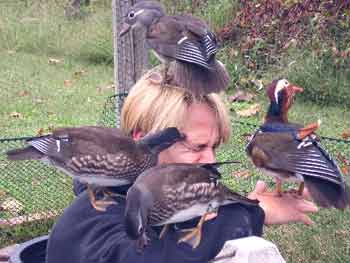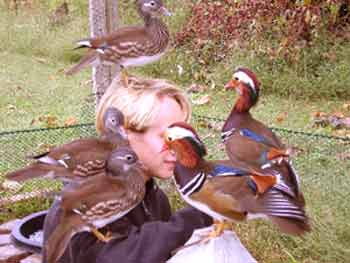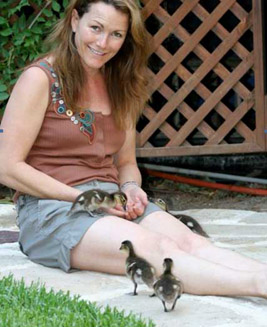Occasionally I am asked why one does not see more Mallards, Mandarins,
and Wood Ducks at shows. After all, the questioner often says, they are all
in the ABA Standard. While it is true that all three species are welcome at
any ABA sanctioned meet, the truth is that their wild temperaments often discourage
exhibitors from showing them. Without proper preparation, Woodies, Mandarins
and Mallards can find the small show cages to be so frightening that they
may well injure themselves trying to escape. With a little training, however,
most individuals can handle the show experience very well. The two processes
necessary are hand taming and coop training and that takes time and effort.

Hand Taming
Hand taming is not only a necessary step in preparing a bird with
a wild temperament for showing, it is also a desirable process if one is to
fully enjoy keeping the birds. While taming is usually attempted with fully
feathered young birds, it can be done with birds of any age. It helps (but
is not mandatory) to disable the bird’s ability to fly in order to aid
in calming the bird. Simply wing clipping the flights on one wing will accomplish
this without rendering the bird permanently flightless. The enclosure in which
the taming will be conducted should allow the keeper to isolate the bird(s)
to be tamed but not so small that the birds cannot move away from the keeper
a little distance if they become frightened. Clean water should be supplied
free choice but feed should be supplied by the keeper only when he/she is
working with the bird(s). The bird should come to associate the keeper with
food. Start by quietly and slowly entering the pen with the food in a bowl
and placing the bowl a few feet in front of the keeper while speaking to the
bird in a calm and soothing voice. Eventually the birds will approach the
bowl and begin to eat. That point is the initial goal the first few times
they are fed. Gradually, the birds will actually anticipate the keeper’s
approach and will move toward him instead of retreating. Each taming session
may only be a few minutes long at that point. As the birds learn to trust
the keeper, the keeper will gradually tempt them to feed directly out of the
hand. That process is greatly aided if one offers special treats such as live
meal worms or other morsels. Not every bird will respond the same and some
will never become as tame as others but all can be taught to trust the close
approach of their keepers given time and patience. Of course, it is necessary
to reinforce the behavior regularly but most keepers enjoy doing so. If the
bird becomes comfortable with handling, so much the better.
Feeding Mandarins out of the hand will tame them quickly.
Coop Training
The goal here is to simply get the bird to be reasonably comfortable
in a show coop. In this process, the bird must be gently caught and placed
in a show coop. The first time or two, the bird should be kept in the coop
for a relatively short time and every effort should be made to calm and comfort
the bird. The bird should then be taken from the coop and released into its
normal pen and rewarded with a special tidbit. The process should be repeated
once or twice a day until the bird appears to accept the coop well. If one
can gradually introduce the bird to more noise and the presence of other people
that would be a plus. Since Mandarins in particular love to perch, adding
a two inch high cross section of a branch it can rest on may make it more
comfortable. No experienced judge should need to handle either Mandarins or
Woodies to evaluate them and most do not feel the need to handle Mallards
unless they suspect the bird may have an off color (white) flight feather.
While Mandarins or Woodies of either sex can certainly be shown, most exhibitors
do not show the less colorful females.

Mandarin ducklings can easily be tamed. Photo by Andrew Markham
While taming and training Mandarins, Wood Ducks, and Mallards may
require more effort than showing the other bantam ducks, having such beautiful
birds in the showroom is certainly worth the effort.







